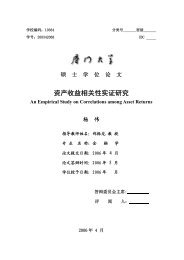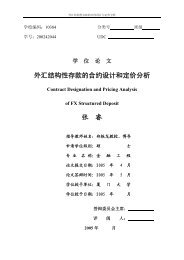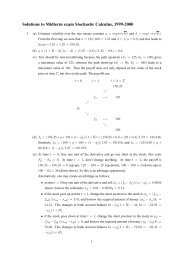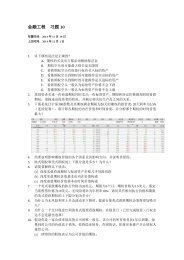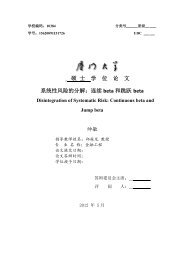The Term Structure of Interest Rates
The Term Structure of Interest Rates
The Term Structure of Interest Rates
You also want an ePaper? Increase the reach of your titles
YUMPU automatically turns print PDFs into web optimized ePapers that Google loves.
THE TERM STRUCTURE OF INTEREST RATES 489<br />
rate structure. Yields on short-term debt average lower than those<br />
on long-term debt because <strong>of</strong> the advantage <strong>of</strong> the superior liquidity<br />
<strong>of</strong> such debt to the holder and the liquidity disadvantage <strong>of</strong> issuing<br />
such debt to private borrowers. <strong>The</strong> amount <strong>of</strong> the liquidity premiums<br />
reflected in the term structure can vary with changes in the<br />
maturity structure <strong>of</strong> outstanding debt and with other factors affecting<br />
marginal preferences for liquidity in investment assets. Behavior<br />
based upon interest rate expectations is important mainly as a factor<br />
determining very short-run movements in long-term rates. Such<br />
behavior is based mainly on near-term expectations, and is ordinarily<br />
<strong>of</strong> little importance in determining average rate levels, and relationships,<br />
over considerable periods <strong>of</strong> time. This theory is summarized<br />
in the following section, and then explored in greater detail.<br />
I. THE ELEMENTS OF TERM STRUCTURE THEORY<br />
<strong>The</strong> decisions <strong>of</strong> borrowers and <strong>of</strong> lenders as to the maturity <strong>of</strong><br />
the debt that they create or hold, and the factors underlying them,<br />
determine the relative market valuation <strong>of</strong> debts <strong>of</strong> different maturities,<br />
in conjunction with government monetary and debt management<br />
policies. Four major factors underlying the market's relative<br />
valuation <strong>of</strong> short-term and long-term debt are described in this<br />
section, and explored somewhat further in later sections. <strong>The</strong>se are:<br />
(1) the liquidity difference between long-term and short-term debt;<br />
(2) the attractiveness <strong>of</strong> debts <strong>of</strong> different maturities on the basis <strong>of</strong><br />
expected future changes in debt prices; (3) short-run effects <strong>of</strong><br />
changes in the maturity structure <strong>of</strong> supply <strong>of</strong> debt coupled with<br />
rigidities in the maturity structure <strong>of</strong> demand for it; and (4) differences<br />
in lending costs related to debt maturity.<br />
Short-term debt is more liquid than long-term debt. This fact<br />
compels some lenders to choose short-term debt, and induces others<br />
to prefer it. If there are limitations on the ability or willingness <strong>of</strong><br />
debtors to do their borrowing by short-term debt, this factor can<br />
thus result in a marginal lender preference for, and lower yields on,<br />
short-term debt. In fact, it is clear that the ability <strong>of</strong> private borrowers<br />
to finance their activities by short-term borrowing is subject<br />
to limitations. Average yields on short-term debt lower than those<br />
on long-term debt can be explained, therefore, as representing the<br />
market's marginal evaluation <strong>of</strong> the superior liquidity <strong>of</strong> existing<br />
short-term debt. This liquidity premium should be affected by<br />
changes in the maturity structure <strong>of</strong> debt supplied to lenders, in<br />
lender attitudes toward liquidity, and in other factors affecting the<br />
liquidity balance in the economy.



